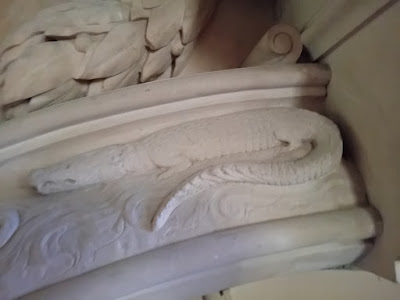The explorer John Hanning Speke was the first European to visit Lake Victoria in East Africa and he correctly identified it as the source of the White Nile.
John Hanning Speke was born on 4th May 1827 at Orleigh Court, Buckland Brewer near Bideford. His family later moved to Jordans near Ilminster. Speke attended Barnstaple Grammar School and Blackheath Proprietary School. In 1844 he was accepted for a commission in the Indian Army. He took part in the 1st and 2nd Anglo-Sikh Wars 1845-6 and 1848-9. He spent his spare time exploring and hunting animals in Tibet and the Himalayas.
In 1854 Speke travelled to Africa for the first time where he joined Richard Burton's expedition to Somalia. The expedition was attacked by a local tribe at Berbera in April 1855 and Speke was seriously injured. He returned to England but almost as soon as he had recovered, he volunteered to fight in the Crimean War. He was attached to a Turkish regiment, but the war soon ended.
In 1856 Speke joined the Royal Geographical Society's expedition to look for the source of the River Nile. He was reunited with Richard Burton and they set off from Zanzibar in June 1857. They reached Lake Tanganyika in February 1858 (the first Europeans to do so). Both Burton and Speke were ill with malaria, but Speke was sufficiently recovered to reach the southern end of a lake, which he named Lake Victoria after Queen Victoria, in August 1858. He decided that Lake Victoria was the source of the River Nile, but Burton disagreed with him, as he was convinced that Lake Tanganyika was the source. The men fell out over this.
In 1860 the Royal Geographical Society funded another expedition to East Africa, so that Speke could confirm his claims about the source of the Nile. He was accompanied by James Augustus Grant. They set off from Zanzibar in September 1860. Speke's two interpreters didn't get on with each other and there were also problems in negotiating safe passage with local chiefs, recruiting porters and getting supplies, which slowed the expedition down for months.
In July 1862 Speke discovered the Nile's exit from Lake Victoria and named it Ripon Falls. James Grant wasn't with him at this point, as he was suffering from an ulcerated leg, so he was unable to confirm Speke's discovery.
Speke's expedition had arranged to rendezvous with ivory trader John Petherick in Gondoroko (now in South Sudan) to collect supplies from him in November 1861. However, it took them until February 1863 to reach Gondokoro. Speke was expecting Petherick to be in Gondokoro to meet them, but he was away doing business elsewhere. He had left supplies for Speke's expedition, but Speke was angry that he was not there to meet them. He was instead welcomed to the city by fellow Nile explorers Samuel Baker and Florence von Sass (who later married Samuel Baker). He and Grant told them of another lake said to lie to the west of Lake Victoria. A few months later Baker and von Sass found the lake, which he named Lake Albert in honour of Queen Victoria's husband. In May 1863 Speke's expedition reached Cairo.
In December 1863 Speke's Journal of the discovery of the source of the Nile was published by William Blackwood & Sons in Edinburgh. Richard Burton challenged Speke's claim to have found the source of the Nile. In 1864 Speke's book What Led to the Discovery of the Source of the Nile was published by Blackwood. This included his own accounts of the earlier Somalia and Lake Tanganyika expeditions.
Roderick Murchison, who was the Director General of the Royal Geographical Society began to dislike Speke because of the way he had treated John Petherick and because he had published his accounts with Blackwood, rather than the Royal Geographical Society. He arranged for Speke and Burton to debate the question of the source of the River Nile at the meeting of the geographical section of the British Association in Bath on 16th September 1864.
On 15th September 1864 Speke went off to shoot partridges at Neston Park near Corsham in Wiltshire. While climbing over a wall he shot himself - it is not clear whether this was an accident or suicide.
Speke was buried in an elaborate tomb at St Andrew's Church, Dowlish Wake. His sarcophagus is made from black/brown serpentine marble. The wall monument above it depicts scenes from his life: a rifle, a sword, a quadrant and a compass on a background of oak leaves. A central baton is entwined with a sash. The inscription A NILO PRAECLARUS (meaning From the Nile Renowned) is on the central panel. A plaster arch, resting on Ham stone plinths and decorated with a hippopotamus, a crocodile and an ibis on each side, surrounds the wall monument. A bust of John Hanning Speke is mounted above the arch.
In 1874-1877 Henry Stanley circumnavigated Lake Victoria by boat and confirmed that the Nile flowed out of Lake Victoria at Ripon Falls and then on to Lake Albert via the Murchison Falls.
Bust of John Hanning Speke in St Andrew's Church, Dowlish Wake
John Hanning Speke's memorial, St Andrew's Church, Dowlish Wake
A NILO PRAECLARUS: From the Nile renowned
Hippopotamus
Crocodile
Egret
Bust of John Hanning Speke in the Museum of Somerset, Taunton























































